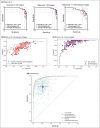What is AI? Applications of artificial intelligence to dermatology
- PMID: 31960407
- PMCID: PMC7497072
- DOI: 10.1111/bjd.18880
What is AI? Applications of artificial intelligence to dermatology
Abstract
In the past, the skills required to make an accurate dermatological diagnosis have required exposure to thousands of patients over many years. However, in recent years, artificial intelligence (AI) has made enormous advances, particularly in the area of image classification. This has led computer scientists to apply these techniques to develop algorithms that are able to recognize skin lesions, particularly melanoma. Since 2017, there have been numerous studies assessing the accuracy of algorithms, with some reporting that the accuracy matches or surpasses that of a dermatologist. While the principles underlying these methods are relatively straightforward, it can be challenging for the practising dermatologist to make sense of a plethora of unfamiliar terms in this domain. Here we explain the concepts of AI, machine learning, neural networks and deep learning, and explore the principles of how these tasks are accomplished. We critically evaluate the studies that have assessed the efficacy of these methods and discuss limitations and potential ethical issues. The burden of skin cancer is growing within the Western world, with major implications for both population skin health and the provision of dermatology services. AI has the potential to assist in the diagnosis of skin lesions and may have particular value at the interface between primary and secondary care. The emerging technology represents an exciting opportunity for dermatologists, who are the individuals best informed to explore the utility of this powerful novel diagnostic tool, and facilitate its safe and ethical implementation within healthcare systems.
© 2020 The Authors. British Journal of Dermatology published by John Wiley & Sons Ltd on behalf of British Association of Dermatologists.
Figures





Comment in
-
Artificial intelligence in dermatology: the 'unsupervised' learning.Br J Dermatol. 2020 Jun;182(6):1507-1508. doi: 10.1111/bjd.18955. Epub 2020 Mar 11. Br J Dermatol. 2020. PMID: 32086797 No abstract available.
References
-
- Turing AMI. Computing machinery and intelligence. Mind 1950; LIX:433–60.
-
- LeCun Y, Bengio Y, Hinton G. Deep learning. Nature 2015; 521:436–44. - PubMed
-
- LeCun Y, Boser BE, Denker JS et al Handwritten digit recognition with a back‐propagation network In: Advances in Neural Information Processing Systems 2 (Touretzky DS, ed.). Burlington, MA: Morgan‐Kaufmann, 1990; 396–404.
-
- Cireşan DC, Meier U, Gambardella LM, Schmidhuber J. Deep, big, simple neural nets for handwritten digit recognition. Neural Comput 2010; 22:3207–20. - PubMed
-
- Krizhevsky A, Sutskever I, Hinton GE. ImageNet classification with deep convolutional neural networks. Neural Inform Proc Systems 2012; 25:3065386.
Publication types
MeSH terms
Grants and funding
LinkOut - more resources
Full Text Sources
Miscellaneous

